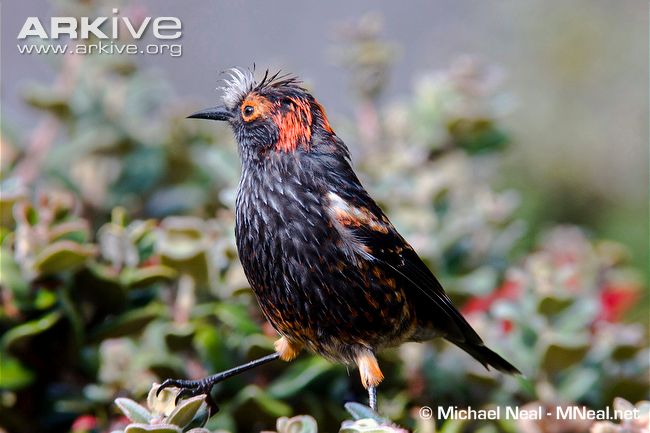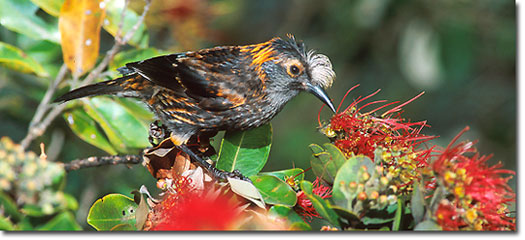
Palmeria dolei
TAXONOMY
Palmeria dolei S. B. Wilson, 1891.
OTHER COMMON NAMES
English: Crested honeycreeper; French: Palmйrie huppйe; German:
Schopfkleidervogel; Spanish: Akojekoje.
PHYSICAL CHARACTERISTICS
7 in (18 cm); 1 oz (29 g); largest living honeycreeper. Sexes are
monochromatic. Unique appearance of black plumage splashed
and streaked with brilliant orange-scarlet and silver. Prominent,
bushy, whitish crest curves forward over the bill. Crest is
often dusted with ohia pollen, thus may serve as a pollinating
organ, as well as a display feature.
DISTRIBUTION
Eastern Maui.
HABITAT
Montane mesic and rainforest from 3,800–6,500 ft
(1,158–1,981 m) above sea level.
BEHAVIOR
Boisterous and aggressive, with a wide range of rough, throaty
calls; native name is derived from one such call. Strong flyer,
chases off other species and conspecifics from preferred feeding
and nesting sites, even attacking with bill and wings.
FEEDING ECOLOGY AND DIET
Feeds mainly on ohia blossom nectar, but supplements the liquid
diet with caterpillars, flies, and spiders.
REPRODUCTIVE BIOLOGY
Monogamous, nesting from November to early June. Females
lay two eggs, parents fledge one or both chicks. Females do incubation
and brooding, males feed females and chicks.
CONSERVATION STATUS
Listed as Endangered federally and by state, and as Vulnerable
by the IUCN. However, the population is stable at 3,800, and
the adult survival rate is 95%.
SIGNIFICANCE TO HUMANS
None known.
Other popular Animals
Photo Gallery of - Akohekohe




 Animalia Life
Animalia Life